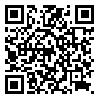BibTeX | RIS | EndNote | Medlars | ProCite | Reference Manager | RefWorks
Send citation to:
URL: http://jdisabilstud.org/article-1-2545-en.html

 , Mohammad Ali Besharat *2
, Mohammad Ali Besharat *2 
 , Mohammad Reza Belyad3
, Mohammad Reza Belyad3 
 , Marjan Hosseinzadeh Taghvaei3
, Marjan Hosseinzadeh Taghvaei3 
 , Parisa Peyvandi3
, Parisa Peyvandi3 

2- Professor, Department of Psychology, Faculty of Psychology and Education, University of Tehran, Tehran, Iran
3- Assistant Professor, Department of Psychology, Karaj Branch, Islamic Azad University, Karaj, Iran
Abstract
Background & Objectives: Spinal cord injury involves damage to the spinal cord that results in temporary or permanent changes in movement, senses, and or the autonomic functioning of the spinal cord. Compared to the general public, patients with spinal cord injury face significant restrictions in various psychological aspects. Given the problems of these patients, the question is which psychological characteristics may play a role in the mental health and resiliency of these patients. In this regard, ego strength and integrative self–knowledge can be mentioned. As an answer to these patients’ need for improving their psychological capabilities, paradox therapy can be a helpful method. Another therapeutic method that can be useful in improving the psychological state of the patients is reality therapy. Accordingly, the main objective of the current study is to evaluate and compare the effectiveness of paradox therapy and reality therapy on the levels of ego strength and integrative self–knowledge in female patients suffering from spinal cord injury.
Method: The research method was quasi–experimental with a pretest–posttest and a follow–up design with a control group. Using random assignment, the subjects were placed in the experimental (paradox therapy and reality therapy) and control groups. The study population comprised 20–40 years old female patients with spinal cord injury, who were members of the Spinal Cord Injury Association of Tehran Province, Iran in 2019. The sample included 45 female patients with spinal cord injury being treated in occupational therapy centers, and willing to participate in the study. The participants were selected based on a voluntary non–random sampling method. The inclusion criteria were as follows: having a female gender, being single, being between 20 and 40 years old, living in Tehran, passing between 5 and 10 years since their spinal cord injury, not participating in psychotherapy at the same time as research, having paraplegic paralysis or two lower limbs with optimal functioning of the upper limbs, either because of the low severity of the injury or because of receiving rehabilitation. The exclusion criteria were as follows: having a history of psychotic diseases and hospitalization in a mental hospital, experiencing the death of first–degree relatives in six months leading to the beginning of interventions, having chronic diseases, being absent of more than two sessions in intervention groups. The Ego Strength Scale (Besharat, 2007) and the Integrative Self–Knowledge Scale (Ghorbani et al., 2003) were utilized in the study. The statistical analysis was performed at the level of descriptive and inferential statistics based on parametric statistical tests. Regarding the inferential analysis, we used 1–way analysis of variance (one–way ANOVA), the Chi–squared test, and ANOVA with repeated measures were used. Moreover, Cohen’s d was used for comparing the effects of target treatments. The significance level of the tests was set at 0.05.
Results: There were significant group (p=0.011), time (p<0.001), and time × treatment effects (p<0.001) for both ego strength and self–knowledge. Post hoc analysis of simple main effects indicated no significant changes in ego strength and self–knowledge for the control group (p>0.05). Compared to the pretest strage, ego strength and self–knowledge for paradox therapy group (p<0.001) and reality therapy group (p<0.001) showed a significant increase in both posttest and follow–up stages. Additionally, compared to the pretest condition, the effect sizes of both treatment plans were almost the same for ego strength (Cohen’s d=2.6), while the effect size of reality therapy (Cohen’s d=2.37) was higher in the follow–up stage than of paradox therapy (Cohen’s d=1.35). In contrast, the effect size of paradox therapy on self–knowledge was quite higher in both posttest (Cohen’s d=1.94) and follow–up (Cohen’s d=2.10) stages than those of reality therapy (Cohen’s d=0.84 in the posttest and Cohen’s d=0.72 in the follow–up).
Conclusions: Paradox therapy and reality therapy are effective in improving deep psychological characteristics of 20–40 years old women with spinal cord injury, i.e., ego strength and integrative self–knowledge. The role of paradox therapy in improving the integrative self–knowledge of patients must be carefully considered by providers of behavioral interventions.
| Rights and permissions | |
 |
This work is licensed under a Creative Commons Attribution-NonCommercial 4.0 International License. |

